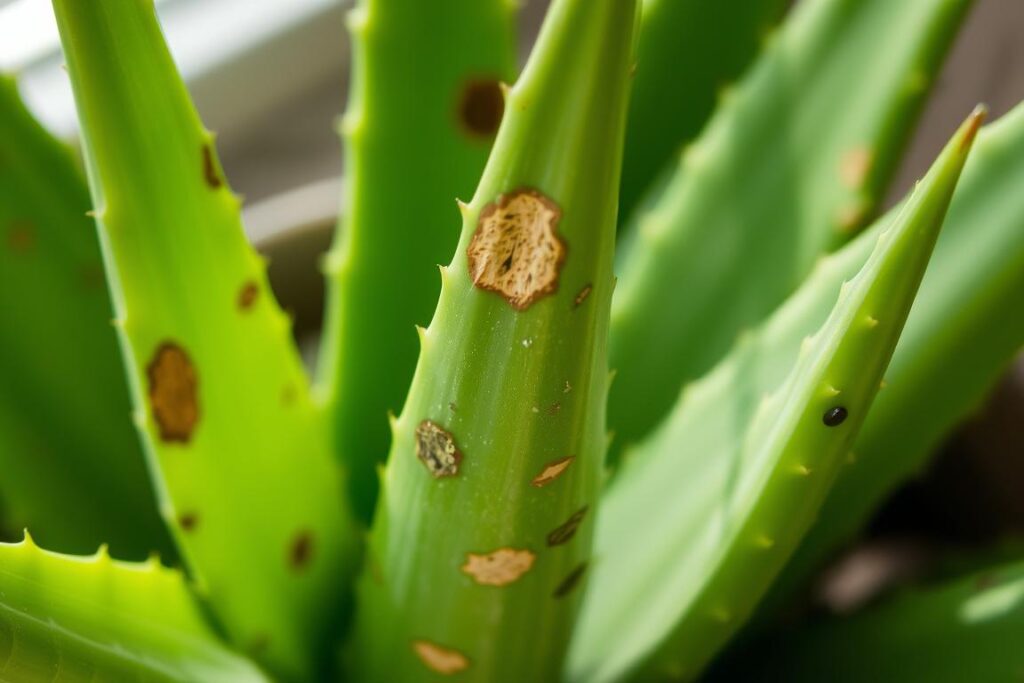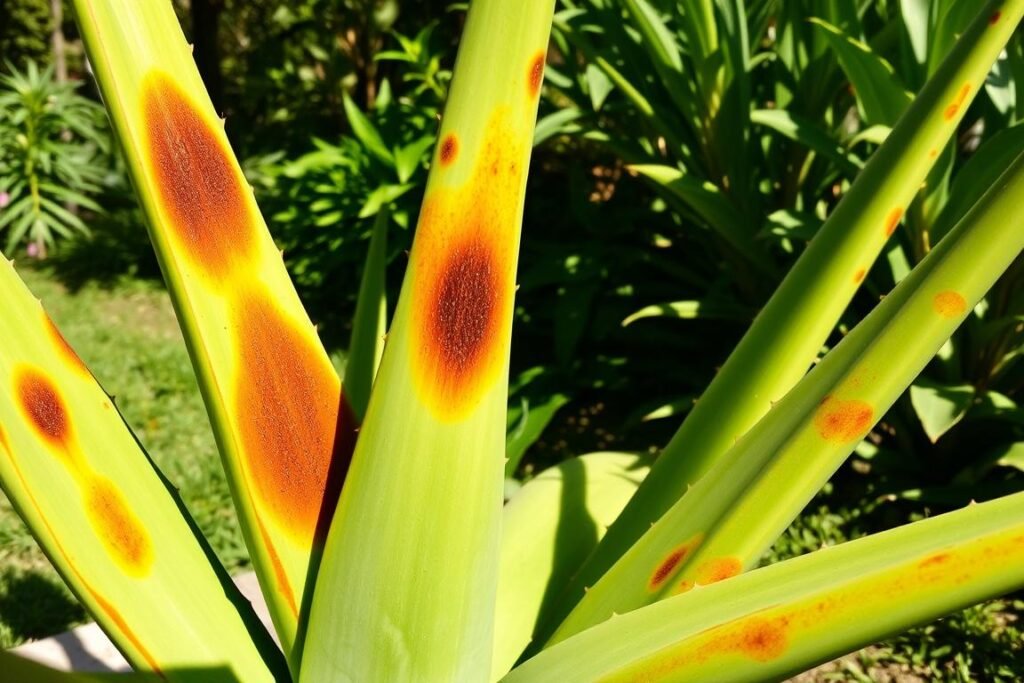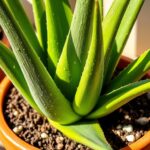I love my aloe vera plant, but brown spots on the leaves are a problem. I wondered why they happened. After some research, I found out several reasons for this issue.

Key Takeaways
- Overwatering is the most common cause of brown spots on aloe vera leaves
- Aloe vera plants require infrequent watering, typically every 2 weeks, with soil monitoring for dryness
- Proper sunlight exposure is crucial, with bright, indirect light being ideal to prevent sunburn
- Temperature fluctuations and pest infestations can also lead to brown spots on aloe vera leaves
- Regular inspections and proactive care are essential for maintaining a healthy aloe vera plant
Understanding Aloe Vera Plant Basics
Aloe vera is a popular houseplant known for its toughness. It can grow well even in tough conditions. This makes it a favorite among plant lovers.
Natural Characteristics of Healthy Aloe Plants
Healthy aloe vera plants have thick, water-storing leaves. These leaves can grow up to 18 inches long. They are pointed at the tips.
Aloe vera likes warm places and bright, indirect light. It also needs well-draining soil to avoid root rot.
Importance of Proper Plant Care
It’s important to keep aloe vera plants watered right. They can handle not being watered often. But, knowing how to care for them is key to keep them healthy.
Common Growth Patterns
Aloe vera plants can grow up to 3 feet tall and 2 feet wide. They bloom many times, making them look great. You can also grow more by separating the pups from the parent plant.
Learning about aloe vera plants helps them grow well. It keeps them healthy and prevents problems like brown spots. This way, you can enjoy their beauty and benefits.
What Causes Brown Spots on Aloe Vera Leaves
Aloe vera plants have thick leaves and can grow well in many places. But, they can get brown spots on their leaves. These spots can come from too much water, pests, or diseases.
Too much water is a big problem for aloe plants. They don’t like wet roots and can rot. This makes the leaves turn brown and soft. Water them only every two weeks in summer and once a month in winter.
Not enough water can also hurt aloe plants. If they don’t get enough moisture, their leaves will wrinkle and dry out. Aloe plants like soil that drains well and should be watered when it’s dry.
Too much sun can also cause problems. Aloe plants like partial shade. Direct sunlight can make their leaves turn brown-red. Keep them in a spot with bright, indirect light.
Brown spots can also mean pests or diseases. Pests like mealybugs can cause spots, and diseases like root rot can too. If you see pests or diseases, act fast to stop them from getting worse.
Finding out why your aloe vera leaves have brown spots is key. Knowing the cause helps you fix the problem. This way, your plant can look healthy again.
| Cause | Symptoms | Prevention/Treatment |
|---|---|---|
| Overwatering | Soft, mushy, brown spots | Water every 2 weeks in summer, once a month in winter |
| Underwatering | Wrinkled, curled, dry, brown leaves | Water when soil feels dry to the touch |
| Sunburn | Brown-red discoloration | Provide partial shade or indirect light |
| Pests | Brown spots, discoloration | Treat with insecticide, wipe leaves with sponge |
| Diseases | Brown spots, wilting, soft leaves | Remove affected parts, treat with fungicide |

Knowing why aloe vera leaves get brown spots helps keep your plant healthy. Watch your plant, water right, and treat pests or diseases fast. This way, your aloe vera will stay happy and green.
Signs of Overwatering and Root Rot
Too much water can hurt your aloe vera plant. It might get brown spots, feel soft, and wilt. These signs mean it’s getting too wet.
Too much water can also cause root rot. This is a big problem that can hurt your plant a lot.
Identifying Water-Related Damage
When aloe vera gets too wet, its leaves turn soft and brown. They might also droop or change color. These are signs it’s getting too much water.
Root System Health Assessment
To check for root rot, gently dig around the plant. Healthy roots are firm and white. But if they’re brown or mushy, it’s root rot.
Frequency of Root Rot Symptoms: If your roots are wilting or yellow, it’s root rot.
Prevention Strategies
- Detection Method: Check the roots by gently digging around the plant. This helps find root rot.
- Trimming and Repotting: Rate of Trimming and Repotting: Cutting off bad roots and repotting in new soil can help your plant get better.
- Watering Frequency: Prevalence of Overwatering: Too much water causes root rot. So, water less often.
- Natural Remedies: Effectiveness of Natural Remedies: Cinnamon and hydrogen peroxide can fight fungal infections and help your plant heal.
- Soil Selection: Impact of Soil Choice: Use soil that drains well to prevent root rot. A mix of loamy, sandy soil with perlite or coarse sand works well.
- Potting and Drainage: Importance of Potting and Drainage: Choose pots with good drainage holes. Terracotta pots are great because they help prevent water from staying too long.
By watching for signs of too much water and keeping the roots healthy, you can avoid problems. This helps your aloe plant stay strong and healthy for a long time.
Sunburn and Light Exposure Problems
Light is key for your aloe vera’s health and look. But too much sun can cause sunburn. This makes leaves turn brown-red and dry out.
To stop sunburn, don’t put your aloe in direct sunlight. Choose a spot with bright, indirect light. A west-facing window is perfect.
If your aloe shows sunburn signs, act fast. Move it to a shaded area or a spot with filtered light. Watch it closely as it heals. With care, your aloe will get better and look great again.
| Symptom | Cause | Prevention | Treatment |
|---|---|---|---|
| Flat, widespread discoloration on leaves | Excessive sunlight exposure | Provide bright, indirect light; avoid direct sunlight | Move plant to filtered light; monitor recovery |
| Leaves turning brown-red and curling/drying | Sunburn damage | Place in west-facing window or shaded area | Relocate to filtered light and wait for recovery |

Right light is vital for your aloe vera plant. Knowing sunburn signs helps protect your plant. This way, your aloe vera stays healthy and useful.
Temperature-Related Stress Factors
Aloe vera plants don’t like extreme temperatures. They can get brown spots on their leaves from stress. Knowing why and how to fix it is key to keeping your plant healthy.
Cold Damage Symptoms
Too cold can hurt your aloe vera. Temperatures under 50°F (10°C) can make leaves soft and brown. This happens when the plant’s cells get damaged.
Heat Stress Indicators
Heat can also harm your aloe vera. High temperatures can dry out the plant. This causes brown, dry spots on the leaves. The plant tries to save water and protect itself.
To keep your aloe vera safe, keep the temperature right. It should be between 55-80°F (13-27°C). Avoid drafts and extreme temperatures. With the right care, your aloe vera will stay healthy and look great.
Common Pest Infestations and Solutions
Keeping your aloe vera plant healthy is important. You need to watch out for pests. These pests can make your aloe look bad and hurt its leaves. Let’s talk about the most common pests and how to fix them.
Mealybugs are a big problem. They look like cotton and suck the plant’s sap. This makes the leaves brown and sticky. To get rid of them, gently clean the leaves with a soft cloth. If they come back, use a special bug spray.
Scale insects are another issue. They look like tiny armor and hurt the plant. Check your aloe often and use a soft brush to remove them.
Spider mites are tiny bugs that suck the plant’s sap. They make the leaves look bad. Keep your aloe in a well-ventilated area and mist it often to keep spider mites away.
- Mealybugs: Cotton-like insects that feed on sap, causing discoloration and brown spots.
- Scale insects: Armored creatures that attach to leaves and stems, disrupting plant health.
- Spider mites: Tiny arachnids that feed on plant juices, leading to discoloration and stippling.
To keep your aloe safe, check it often and give it the right care. With a little effort, your aloe will stay healthy and beautiful for a long time.
Fungal and Bacterial Diseases
Aloe vera plants can get sick from fungal and bacterial diseases. These can cause brown spots on their leaves. Knowing how to treat these infections is key to keeping your aloe plants healthy and looking good.
Types of Infections
Some common diseases in aloe vera include:
- Anthracnose (Colletotrichum gloeosporioides)
- Leaf spot (Curvularia sp.)
- Cladosporium leaf spot
- Leaf blight (Alternaria alternata)
- Bacterial soft rot (Pectobacterium chrysanthemi)
These diseases show up as brown to black spots on leaves. They can also cause leaves to become mushy and smell bad.
Treatment Methods
To fight these diseases, follow these steps:
- Use clean, sterilized tools to cut off any sick leaves. This stops the disease from spreading.
- Make sure there’s good air flow around your aloe plants. This helps keep humidity down and stops diseases from growing.
- Use a fungicide or bactericide as directed. This will help kill the specific disease affecting your plants.
Keep your plants far apart, don’t water from above, and watch for disease signs. This can help stop fungal and bacterial infections in your aloe vera garden.
Nutrient Deficiencies and Soil Problems
Nutrient deficiencies and soil problems can cause brown spots on aloe vera leaves. Poor soil quality or the wrong pH levels can stress the plant. To keep my aloe vera healthy, I plant it in well-draining, slightly acidic soil (pH 6.0-6.5).
I also use a balanced, diluted fertilizer for succulents during the growing season. This helps prevent nutrient deficiencies.
Checking the soil quality regularly is important. Making adjustments as needed helps my aloe vera grow well. Proper soil care and nutrient management prevent brown spots and keep my aloe vera thriving.
Well-draining soil, the right nutrients, and careful watering are key. These steps help my aloe vera stay healthy and vibrant. By focusing on these basics, I can avoid brown spots and other problems. This keeps my aloe vera a beautiful part of my space.
FAQ
What causes brown spots on aloe vera leaves?
Brown spots can come from too much water, not enough water, too much sun, or bad temperatures. Pests and diseases also play a part.
What are the natural characteristics of healthy aloe plants?
Healthy aloe plants have thick leaves that hold water and vitamins. They like bright, indirect light and soil that drains well.
Why is proper aloe plant care important?
Right care means the right water, light, and temperature. Knowing how to care for your plant helps avoid brown spots.
How can overwatering cause brown spots on aloe vera leaves?
Too much water makes leaves soft and mushy. It can also cause the roots to rot, harming the plant more.
What are the signs of sunburn on aloe vera leaves?
Sunburn shows as flat, wide discoloration. It turns leaves brown-red, then curls and dries them out.
How can temperature stress affect aloe vera plants?
Cold stress makes spots soft and watery. Heat stress causes dry, brown patches on leaves.
What pests can cause brown spots on aloe vera leaves?
Pests like mealybugs, scale insects, and spider mites can cause small brown spots. They also leave visible damage.
What fungal and bacterial diseases can affect aloe vera plants?
Diseases like anthracnose and leaf spot can cause brown spots. Cladosporium leaf spot and leaf blight also affect leaves.
How can nutrient deficiencies and soil problems contribute to brown spots?
Bad soil, wrong pH, or missing nutrients stress the plant. This can make leaves turn brown.






